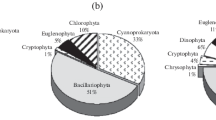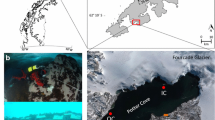Abstract
Periphyton was collected from sand-blasted slides exposed in the main channel of River Danube at Gö (1669 rkm). Samples were taken from 21 May to 23 November in 1984. Three to four days after placing the substrates into the river the first traces of an observable coating appeared. The formation of the algal coating in the Danube presented certain periodical features. From time to time, an essential decrease in the number of individuals could be observed, which generally coincided with changes in the struc- ture of the community. This could be traced well, by grouping the algae according to morphological categories and following the temporal changes affecting these categories. The early phase of the colo- nization process is dominated by relatively large araphid and biraphid diatoms. In the second phase small bi- and monoraphid species are dominant. Finally, the medium size mono- and biraphid algae are dominating.
Similar content being viewed by others
References
Ács, É. & K. T. Kiss, 1991. Investigation of periphytic algae in the Danube at Göd (1669) river km, Hungary. Arch. Hydrobiol. Suppl. Bd. 89., Algol. Studies 62: 47–67.
Bereczky, C. M., N. Oertel & J. Nosek, 1983. Die tiefenabhängige Entwicklung des Protozoenaufwuchses auf künstlichem Substrat in der Donau 1. Die Frage der Tiefenschichtung. Arch. Hydrobiol. Suppl. 68: 37–62.
Blinn, D. W., A. Fredericksen & V. Korte, 1980. Colonization rates and community structure of diatoms on three different rock substrata in a lotic system. Br. phycol. J. 15: 303–310.
Cattaneo, A., 1983. Grazing on epiphytes. Limnol. Oceanogr. 28:124–132.
Cattaneo, A. & J. Kalff, 1986. The effect of grazer size manipulation on periphyton communities. Oecologia 69: 612–617.
Czekanowski, J., 1909. Zur differential Diagnose der Neandertalgruppe. Korrespbl. dt. Ges. Anthrop. 40: 44–47.
Jaccard, P., 1908. Nouvelles recherches sur la distribution florale. Bull. Soc. Vand. Sci. Nat. 44: 223–270.
Johansson, C., 1979. Chlorophyll content and the periphytic algal vegetation in six streams in northern Jämtland, Sweden 1977. Medd. Växtbiol. inst. 2: 1–27.
Kétyi, I., 1983. Általános bakteriológia. In L. Váczi (ed.), Orvosi mikrobiológia-immunitástan-parazitológia. Medicina Könyvkiadó, Budapest, 542 pp.
Kiss, K. T., 1984. Changes of trophity conditions in the River Danube at Göd. Danub. Hung. XCIV. Ann. Univ. Sci. Budapest 24–26: 47–59.
Krammer, K., H. Lange-Bertalot, 1986: Bacillariophyceae 1: Naviculaceae. In H. Ettl, J. Gerloff, H. Heynig, D. Mollenhauer (eds), Süsswasserflora von Mitteleuropa, 2/1. G. Fischer Verlag, Jena.
Krammer, K., H. Lange-Bertalot, 1986: Bacillariophyceae 2:Bacillariaceac, Epithemiaccae, Surirellaceae. In H. Ettl, J. Gerloff, H. Heynig, D. Mollenhauer (eds), Süsswasserflora von Mitteleuropa, 2/2. G. Fischer Verlag, Jena.
Lakatos, G., 1977. Investigation of the colonizational dynamic of attached organisms (biotecton) in a short term experiment. Acta Biol. Debrecina 14: 95–103.
Lund, J. W. G., C. Kipling & E. D. Lecren, 1958. The inverted microscope method of estimating algal numbers and the statistical basis of estimations by counting. Hydrobiologia 11: 143–170.
Patrick, R., 1967. The effect of invasion rate, species pool, and size of area on the structure of the diatom community. Proc. natn. Acad. Sci. U.S.A. 58: 1335–1342.
Podani, J., 1988. Syn-Tax III. User's Manual. Abstr. Bot. 12 1–183.
Sommer, U., 1981. The role of r- and K-selection in the succession of phytoplankton in Lake Constance. Acta Oecol. Oecol. Gener. 2: 327–342.
Sørensen, T., 1948. A method for establishing groups of equal amplitude in plant sociology based on similarity of species content and its application to analyses of the vegetation on Danish commons. Biol. Skr. 5: 1–34.
Stevenson, R. J., 1986a. Importance of variation in algal immigration and growth rates estimated by modeling benthic algal colonization. In L. V. Evans & K. D. Hoagland (eds), Algal Biofouling. Elsevier Press, Amsterdam: 193–210.
Stevenson, R. J., 1986b. Mathematical model of epilithic diatom accumulation. In M. Ricard (ed.), Proceedings of the 8th International Diatom Symposium. O. Koeltz, Koenigstein: 323–335.
Stevenson, R. J. & C. G. Peterson, 1989. Variation in benthic diatom (Bacillariophyceae) immigration with habitat characteristics and cell morphology. J. Phycol. 25: 120–129.
Stevenson, R. J., C. G. Peterson, D. B. Kirschtel, C. C. King & N. C. Tuchman, 1991. Density-dependent growth, ecological strategies, and effects of nutrients and shading on benthic diatom succession in streams. J. Phycol. 27: 59–69.
Utermöhl, H., 1958. Zur Vervollkommnung der quantitativen Phytoplankton-Methodik. Mitt. int. Ver. Limnol. 9: 1–38.
Author information
Authors and Affiliations
Rights and permissions
About this article
Cite this article
Ács, É., Kiss, K.T. Colonization processes of diatoms on artificial substrates in the River Danube near Budapest (Hungary). Hydrobiologia 269, 307–315 (1993). https://doi.org/10.1007/BF00028029
Issue Date:
DOI: https://doi.org/10.1007/BF00028029




